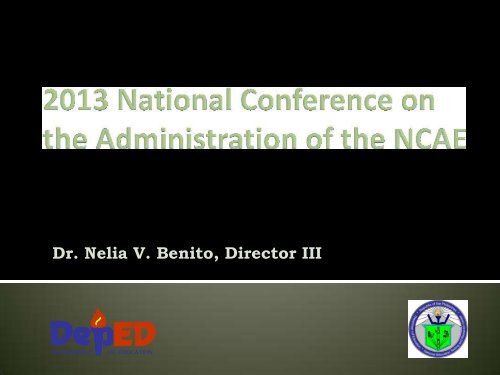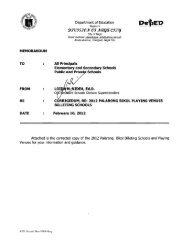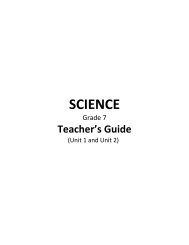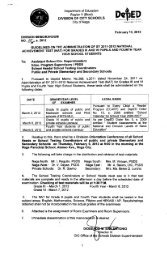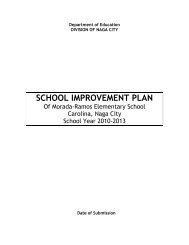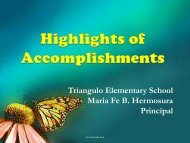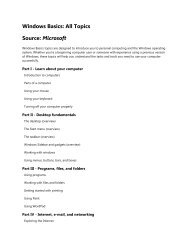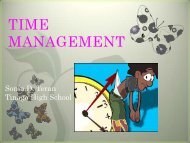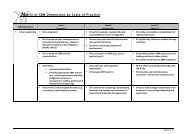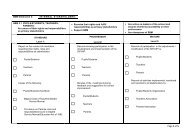NCAE - DepEd Naga City
NCAE - DepEd Naga City
NCAE - DepEd Naga City
- No tags were found...
You also want an ePaper? Increase the reach of your titles
YUMPU automatically turns print PDFs into web optimized ePapers that Google loves.
1. What is the <strong>NCAE</strong>?• <strong>NCAE</strong> = National Career Assessment Examination• It is an aptitude test geared toward providing informationthrough test results for self-assessment, career awareness andcareer guidance of high school students for their post-secondarycourses / application for scholarship.• Test-taking is mandatory.• Test results are recommendatory.4
2. What other features characterize the <strong>NCAE</strong>? A locally developed test which was standardized andvalidated using Filipino respondents A paper-and-pencil test which utilizes scannable answer sheetsthat are processed electronically A multiple-choice type of test Culture fair and sensitive Provides an end-user-friendly report format (COR) 5
3. Why was <strong>NCAE</strong> developed?The <strong>NCAE</strong> was developed to:• To foster the highest quality of education in the Philippines byregulating and monitoring the flow of students to post secondaryinstitutions of learning and their potential contribution to nationaldevelopment• To minimize indiscriminate wastage of manpower andresources by working for a match between manpower skill outputsand job market demands6
4. What are the specific objectives of the <strong>NCAE</strong>?• To assess the skills of high school students planning to proceed to postsecondary courses and other career options, toward providing relevantinformation on their skills, abilities and readiness for academic and nonacademiccourses;• To provide information that will help high school students make wise careerdecision; and• To provide bases for selecting scholarship awardees and recipients of studygrants from the Commission on Higher Education (CHED) and the TechnicalEducation and Skills Development Authority (TESDA).7
5. How is <strong>NCAE</strong> different from NCEE?Similarities• Both are generalscholastic aptitude tests(GSAT)Differences• <strong>NCAE</strong> includes scientific ability as anarea in GSAT• Still recommendatory – without cut-offscore• Includes technical-vocational aptitude,entrepreneurial skill, non-verbalability, logical reasoning ability andinterest inventory8
6. Who are the target examinees of the <strong>NCAE</strong>?• All enrolled Third Year HS students in public and privatehigh schools operating with permit• Fourth Year HS Students and out-of-school youths whoare applying for the CHED and TESDA scholarship9
7. What are the domains measured in the <strong>NCAE</strong>?A. General Scholastic Aptitude (GSA) – 180 items• Scientific Ability (SA) ------------------------------------------------- 40 items• Reading Comprehension (RC) ------------------------------------- 50 items• Verbal Ability (VA) ---------------------------------------------------- 50 items• Mathematical Ability (MA) ------------------------------------------ 40 itemsB. Technical-Vocational Aptitude (TVA) – 40 items• Clerical Ability (CA) -------------------------------------------------- 20 items• Visual Manipulative Skills (VMS) ---------------------------------- 20 itemsC. Entrepreneurial Skills (ES) -------------------------------------------------- 20 items• Planning and Decision Making (PD)• Budgeting, Marketing and Forecasting (BMF)• Creativity (C)D. Logical Reasoning Ability (LRA) ------------------------------------------ 15 itemsE. Non-Verbal Ability (NVA) --------------------------------------------------- 20 itemsF. Occupational Interest (OIISSS)--------------------------------------------- 260 items10
Areas of Occupational Interests:A. SciencesB. EngineeringC. CommerceD. Professional ServicesE. Personal ServicesF. CyberservicesG. AestheticsH. EnvironmentI. Military TrainingJ. Spiritual VocationK. Agriculture and Fishery11
Occupational Interest Inventory of Students in Secondary Schools(OIISSS)‣ This is an inventory / checklist of occupational interests which providesan assessment on inclinations / preferences for comprehensive careerguidance.‣ The students are provided with a profile chart of their occupationalinclinations and preferences thru the identified cluster occupations.‣ These major occupations are finely divided into two specific groups – thebaccalaureate courses and vocational courses.12
8. What information is derived from the <strong>NCAE</strong> COR?• COR = Certificate of Rating• The COR contains the report on how the examinees performed inthe test which is presented in a graph alongside the StandardScores and Percentile Ranks.• The descriptive rating of the Percentile Rank is also included.• The overall GSA and TVA scores are reported along with scores inthe subtests.• The GSA score is the average of the standard scores in theseareas: SA, RC, VA and MA.13
• Likewise, the TVA score is the composite of the CA and VMSscores.• Additionally, the <strong>NCAE</strong> reports scores for LRA, NVA and ES.• The level of preference for each area of occupational interest isdisplayed based on percentage score which is as follows: high (76-100), moderate (51-75), low (26-50) and very low (0-25)• Examinees can gauge their individual strengths and weaknessesin every domain/area measured based on the test results.14
Facsimile of the <strong>NCAE</strong> COR (2012)FRONTBACKTDPU-pjdc/7/16/12Potentials/Inclinations of Students Based on <strong>NCAE</strong> ResultsScientific A bility (SA ). This is an assessment of the individual'sscientific abilities and skills to adopt scientific methods, procedures andC lerical A bility (C A ). This is a test of ability and skill to encodeprocesses constructing knowledge and solving experimental or real-lifedata/information and file office records, as well as ability to note details. High CAproblems. One who has high SA has greater probability to excel in academicis the requisite skill for secretariat jobs for these jobes require good manualprograms that work mostly onscientific methodologies (e.g. medical allieddexterity; thus individuals with high CA are potential computer operators.professions). Those with average SA can be successful in the field ofencoders, and stenographers.chemistry, physics, zoology, botany, biology, and other courses related toR eading C o mprehensio n (R C ). This measures the ability tounderstand what has been stated directly; to anlayze, interpret, and criticizewhat has been read; to recognize reasonable application of principles oropinions expressed by the author. A student with hig RC has the potentialto make sound inferences, syntheses, generalizations, or conclusions onwhat he/she read. Students who possess the skills will most likely succeedin courses that involve public speaking and even writing such as masscommunication, teaching, theology, and law.Verbal A bility (VA ). This subtest measures the assertive ability of aperson in view of grammatical rules and logical arrangement of ideas.Individuals with hig VA have high sense of analogy; hence, they havepotential in mass communication, law, teaching, and preaching vocation.Those with average VA can be developed in advertising careers.M athematical A bility (M A ). This subtest is used to assessquantitative abilities and computational skills, particularly, on working withnumbers, perceiving relationship between two quantities and solving wordproblems. One with high MA has high sense of mathematical calculus, arequisite skill in engineering courses, aeronautics and marine courses.Visual M anipulative Skills (VM S). This subtest measures abilities thatrequire perceptual and visual judgment in determining figures, symbols, andnature of space as well as skills in mentally manipulating objects and concretematerials. M anipulative skills are required in occupations such as machinetechnicians, jewelers, watchmakers, engravers, handicraft makers, and the like.N o nverbal A bility (N VA ). This tests a person's reasoning ability to identifypatterns presented in diagrammatic form. The series of figures presented in eachitem requires the perception of an operating principle underlying the changes inthe figures. In each instance, the examinee must discover the principle'sgoverning change/s of the figures and give evidence of his understanding byindicating the diagram that should logically follow. It tests abilities required in jobssuch as engineering, science, architecture and any other jobs which involveworking with diagrammatic and similar visual information.Lo gical R easo ning A bility (LR A ). This measures an individual's ability tounderstand and analyze complex written material and derive correct conclusionsfrom it. Those with high LRA are likely to succeed in courses which require highanalytical/critical thinking skills like law, economics, theology, social science andmedical allied professions.AN INVENTORY OF OCCUPATIONAL INTERESTSA. SCIENCES B. ENGINEERING D. PROFESSIONAL F. CYBERSERVICES GarmentsHealth - Medical B1 Mechanical Engineer SERVICES (cont...) F1 Web Designer G27 Shoe Maker**A1 Doctor of Medicine B2 Electrical Engineer D11 Registrar F2 Analy st G28 Furniture Maker**A2 Dentist B3 Civ il Engineer D12 Values Teacher F3 Programmer G29 Pottery Maker**A3 Pharmacist B4 Safety Engineer D13 College Professor F4 Instructor G30 Beadw orks Maker**A4 Medical Technologist B5 Mining Engineer D14 Non-Formal Educ Teacher F5 Transcriptionist G31 Jew elry Maker**A5 Nurse B6 Metallurgical Engineer D15 Tech-Vocational Aide** F6 Data Encoder** G32 Silk Screen Maker**A6 Orthodentist B7 Marine Engineer D16 Book Author F7 Cartoonist** G33 T-shirt Designer**A7 Optometrist B8 Agricultural Engineer D17 Composer F8 Animator** G34 Wood Carv er**A8 Cardiologist B9 Chemical Engineer D18 Guidance Counselor F9 Illustrator** G35 Art Painter**A9 Geneticist B10 Electrician** D19 School Head F10 Clerk** G36 Caricaturist**A10 Laboratory Technician** B11 Technician** D20 Assistant Principal F11 Repairman**A11 Radio Technician** B12 Car-auto Machinist** D21 School Clerk** F12 Radio Technician** H. ENVIRONMENTB13 CP-radio Technician** D22 School Aide** F13 Online Sales Agent** H1 Urban PlannerSpecialized Areas B14 Heav y Equip Operator** D23 Janitor** F14 Technician** H2 Real Estate Broker**A12 Geologist B15 Gardener** D24 Security Officer** F15 Call Center Agent** H3 Designer**A13 Actuarial Mathematician B16 Hobby ist** F16 Database** H4 Sales Representativ e**A14 Biologist B17 Goldsmith** E. PERSONAL SERVICES F17 Adv ertising Agent** H5 Driv er**A15 Marine Biologist E1 Av iation-Pilot F18 Computer Aide** H6 ForesterA16 Food Technologist C. COMMERCE E2 Stew ardess F19 Drafters**A17 Radiologist C1 Marketing Officer E3 Ground Crew I. MILITARY TRAININGA18 Chemist C2 Banker E4 Radio Comptroller G. AESTHETICS I1 Armed Forces OfficerA19 Botanist C3 Budget Officer E5 Technician** Cosmetics I2 Military OfficerA20 Statistician C4 Financial Analy st E6 Tow er Technician** G1 Make-up Artist** I3 Police OfficerA21 Zoologist C5 Accountant E7 Maritime-Ship Captain G2 Hair Cutter** I4 Police Aide**A22 Volcanologist C6 Bookkeeper E8 Chief Mate G3 Manicurist** I5 Desk Officer**A23 Doctor of Veterinary Med C7 Businessman E9 Marine Engineer G4 Hair Sty list** I6 Air Force OfficerA24 Seismologist C8 HR Manager E10 Messman/Cook** G5 Hair Spa Aide** I7 Traffic Enforcer**A25 Laboratory Aide** C9 Sales Manager E11 Seaman** I8 Barangay Tanod**A26 Laboratory Assistant** C10 Economist E12 Trav el Agent House Construction I9 Inv estigatorC11 Adv ertising Ex ecutiv e E13 Tour Guide** G6 Architect I10 Labor LeaderAllied Medical Science C12 Stockroom Superv isor** E14 Photographer** G7 Surv ey or I11 Training OfficerA27 Speech Pathologist C13 Salesclerk** E15 Ticketing Clerk** G8 Interior Designer I12 StrategistsA28 Occupational Therapist C14 Storekeeper** E16 Hotel-HRM G9 Foreman I13 Barangay Officer**A29 Therapy Assistant** C15 Cashier** E17 HR Superv isor G10 Building Aide** I14 Rescue Volunteer**A30 Medical Representativ e C16 Records Officer** E18 Maintenance Superv isor G11 Painter** I15 Barangay Aide**A31 Medical Superv isor C17 Clerk** E19 Chef G12 Driv er** I16 Barangay Cleaners**A32 Barangay Health Official** C18 IT Sales Clerk** E20 Attendant** G13 Pipe Welder** I17 Clerk**A33 Hospital Manager C19 Security Officer** E21 Clerk** G14 Carpenter** I18 ForensicA34 Laboratory Utility ** C20 Sales Promo** E22 Baker** G15 Mason** I19 DNA Analy stsA35 Caregiv er** C21 Warehouse Superv isor** E23 Elev ator Man** I20 Fingerprint Ex pertE24 Chambermaid** Theater/Movie I21 Laboratory Technician**Medical Tourism/Wellness D. PROFESSIONAL E25 Barista** G16 Artist/Actor I22 Laboratory Encoder**A36 Cosmetic Surgeon SERVICES E26 Reserv ation Clerk** G17 DirectorA37 Dermatologist D1 Legal-Judge E27 Billing Clerk** G19 Set Designer** J. SPIRITUAL VOCATIONA38 Orthopedic Doctor D2 Law y er E28 Mass Comm-Journalist G20 Lights Designer** J1 Priest/PastorA39 Herbologist D3 Clerk of Court E29 New s Editor G21 Entertainer**A40 Chiropractor D4 Legal Assistant** E30 Cameraman** K. AGRICULTURE & FORESTRYA41 Optical Aide** D5 Legal Secretary ** E31 Voice Ov er Talent** Garments K1 Canning WorkerA42 Nursing Aide** D6 Clerk** E32 Technician** G22 Tex tile Technician K2 Agriculutural WorkerA43 Spa Aide** D7 Pre-School Teacher E33 Operator** G23 Fashion Designer K3 Fish Hachery TechnicianA44 Gy m Instructor** D8 Teacher Aide** E34 Telephone Operator** G24 Wholesaler** K4 AquaculturistA45 Medical Secretary ** D9 Elementary Teacher E35 Proofreader** G25 Dressmaker**A46 Sales Representativ e** D10 High School Teacher E36 Dubber** G26 Bag Maker**15
9. How are the <strong>NCAE</strong> scores reported and interpreted?• The scores are reported in Standard Scores and Percentile Ranks.• Standard Score - where the mean is 500 and the standard deviationis 100. The highest scores are in the 700’s; the lowest scores are in the300’s.• Percentile Rank - shows the examinees’ position among all theexaminees. If an examinee scores at percentile rank 99+, it means thathe scored above the other 99 percent of the examinees.16
X• PR = 8017
10. What is the legal basis of the <strong>NCAE</strong>?18
11. Is <strong>NCAE</strong> a prerequisite for entry to college?• Yes. <strong>NCAE</strong> will be part of the requirements for admission to thetertiary education institutions starting SY 2010-2011.• Although a requirement, the results of the <strong>NCAE</strong> are stillrecommendatory. There is still no passage of law that makes theresults of the <strong>NCAE</strong> mandatory prior to enrolment incollege/university courses or in vocational/technological courses orother short entrepreneurial courses.19
2020
12. Is there a testing fee required in taking the <strong>NCAE</strong>?• None.• The cost in the preparation of test materials andadministration of the test does not entail any amountfrom the schools, parents and students.• All expenses are shouldered by the Department.21
13. How long does it take for an examinee to receivehis/ her individual COR (test results)?• 3-4 months22
14. How will the <strong>NCAE</strong> guide high school students and their parentsin determining the career track they should take?• The <strong>NCAE</strong> intends to provide information that will help outgoing high schoolstudents make wise career decisions based on the results of the three domains ofthe test.• It also provides an interest inventory that will show the inclinations of thestudents in a particular occupational field.• The test results will validate the previously thought career choice by showingthe student’s strengths and weaknesses in the aforementioned domains.23
15. How has the general public responded to the results of the exam? Are parentswilling to follow the test results for their children’s career plans?• In 2007, DepED-NETRC conducted a survey on the utilization of the <strong>NCAE</strong>results for SY 2006-2007.• Nineteen (19) higher education institutions and TESDA accreditedschools in twelve (12) schools divisions participated in the survey.• The <strong>NCAE</strong> annual administration was viewed positively by 81.31% of thestudents.• 80% of their parents affirmed in the necessity to administer the <strong>NCAE</strong>yearly.24
• 85% of the school officials favored the annual administration ofthe <strong>NCAE</strong>.• Across the four groups of respondents (students, parents, schoolofficials and CHED/TESDA institutions), the <strong>NCAE</strong> elicited highacceptance level.• All groups manifested agreement on the yearly administration ofthe <strong>NCAE</strong>.25
16.Based on the results of the test, what are the policy directions ofDepED on the basic education curriculum?Policy Directions:• Based on the results of the <strong>NCAE</strong> over the years, majority of ourhigh school graduates have inclinations toward technical-vocational(tech-voc) occupations.• The strengthening of 261 technical-vocational high schools isbeing carried out by the Department wherein improvements arebeing made in their curriculum, training, physical and policysupport.26
• The results validate DepED’s decision to put great stress on tech-voc program,that is, to equip high school students with technical-vocational skills that canempower them to find meaningful employment, whether or not they pursuecollege education.• DepED’s tech-voc curriculum is being aligned with the training regulations ofTESDA. This will allow tech-voc high school graduates to acquire TESDAcertificates.• It is also the Department’s goal to improve the abilities of students in thegeneral scholastic domain.27
• Moreover, the Department is currently working onintensifying the career guidance programs inpublic national high schools and in orienting theguidance staff in the schools and division offices onhow to maximize the utilization of the <strong>NCAE</strong> resultsin order to properly guide students in making wisecareer decisions.28
17. How can the results of the exam help solve the problem of jobmismatch?• With the results of the <strong>NCAE</strong>, the students will bedirected to occupational fields where they would bepotentially productive and successful.29
18. Can the results of the <strong>NCAE</strong> be used in ranking schools?• No.• The results of the <strong>NCAE</strong> should NOT be used for otherpurposes other than career guidance.30
32Y3 Number of Examinees:Public 1,256,841Private 340,597TOTAL 1,597,438• Date of Examination: August 29, 2012DEPARTMENTOF EDUCATION32
Areas # of Items MRS* SD MPSGeneral Scholastic Aptitude GSA 180 68.16 21.45 37.87Scientific Ability SA 40 12.51 5.06 31.28Reading Comprehension RC 50 23.35 8.24 46.70Verbal Ability VA 50 18.83 6.75 37.66Mathematical Ability MA 40 13.48 5.39 33.70Technical-Vocational Aptitude TVA 40 24.13 7.10 60.33Clerical Ability CA 20 12.83 4.17 64.15Visual Manipulative Skill VMS 20 11.30 3.92 56.50Non-Verbal Ability NVA 20 8.67 3.85 43.35Logical Reasoning Ability LRA 15 5.22 2.72 34.80Entrepreneurial Skill ES 25 11.20 3.60 44.80Planning & Decision Making PD 4 1.70 1.11 42.50Budgeting, Marketing & Forecasting BMF 11 3.97 2.10 36.09Creativity C 10 5.52 1.77 55.20*Mean Raw Score33
PERFORMANCE IN MEAN PERCENTAGE SCORE<strong>NCAE</strong> SY(2012-2013)National Mean Performance by DomainWhat is the performance of junior high school students in Mean Percentage Scoresin the <strong>NCAE</strong> subtests?Mean in Percentage Score70.0064.1560.0055.2056.50 60.33 43.3550.0040.0030.0031.2846.7037.66 33.7037.8734.8042.5036.0944.8020.0010.000.00SA RC VA MA GSA CA VMS TVA NVA LRA PD BMF C ES34
Cluster 1 Regions:(Large: with 100,001examinees and aboveCluster 2 Regions:(Medium: with 75,000examinees to 100,000)Cluster 3 Regions:(Small: with 74,999examinees and below)Ilocos Region Eastern Visayas Cagayan ValleyWestern Visayas Southern Mindanao MIMAROPACentral Luzon Northern Mindanao Western MindanaoCentral Visayas Central Mindanao CARCALABARZONNCRBicol RegionARMMCARAGA35
What is the percentage distribution of <strong>NCAE</strong> examinees by aptitude level in GSA and cluster of regions?APTITUDE LEVELREGIONAL CLUSTER1 2 3Totaln % n % n % n %HIGH 10,983 1.04 1,483 0.55 1,535 0.56 14,001 0.88MODERATE 169,407 16.11 31,662 11.66 38,232 13.95 239,301 14.98LOW 871,488 82.85 238,374 87.79 234,274 85.49 1,344,136 84.14TOTAL 1,051,878 100 271,519 100 274,041 100 1,597,438 100Cluster of Regions:1 = Large (100,001 examinees and above)2 = Medium (75,000 examinees to 100,000)3 = Small (74,999 examinees and below)36
What is the percentage distribution of <strong>NCAE</strong> examinees by aptitude level in TVA and cluster of regions?APTITUDE LEVELREGIONAL CLUSTER1 2 3Totaln % n % n % n %HIGH 294,318 27.98 57,329 21.11 56,420 20.59 408,067 25.55MODERATE 515,513 49.01 132,829 48.92 128,532 46.90 776,874 48.63LOW 242,047 23.01 81,361 29.97 89,089 32.51 412,497 25.82TOTAL 1,051,878 100 271,519 100 274,041 100 1,597,438 100Cluster of Regions:1 = Large (100,001 examinees and above)2 = Medium (75,000 examinees to 100,000)3 = Small (74,999 examinees and below)37
What is the percentage distribution of <strong>NCAE</strong> examinees by aptitude level and by cluster of regions in NVA?APTITUDE LEVELREGIONAL CLUSTER1 2 3Totaln % n % n % n %HIGH 97,648 9.28 16,081 5.92 18,279 6.67 132,008 8.26MODERATE 361,555 34.37 70,456 25.95 72,787 26.56 504,798 31.60LOW 592,675 56.34 184,982 68.13 182,975 66.77 960,632 60.14TOTAL 1,051,878 100 271,519 100 274,041 100 1,597,438 100Cluster of Regions:1 = Large (100,001 examinees and above)2 = Medium (75,000 examinees to 100,000)3 = Small (74,999 examinees and below)38
What is the percentage distribution of <strong>NCAE</strong> examinees by aptitude level and by cluster of regions inEntrepreneurial Skills?APTITUDE LEVELREGIONAL CLUSTER1 2 3TotalCluster of Regions:1 = Large (100,001 examinees and above)2 = Medium (75,000 examinees to 100,000)3 = Small (74,999 examinees and below)n % n % n % n %HIGH 35,263 3.35 6,273 2.31 7,477 2.73 49,013 3.07MODERATE 342,764 32.59 72,373 26.65 72,784 26.56 487,921 30.54LOW 673,851 64.06 192,873 71.03 193,780 70.71 1,060,504 66.39TOTAL 1,051,878 100 271,519 100 274,041 100 1,597,438 10040
What is the aptitude level of the junior high school students in the <strong>NCAE</strong> domains?<strong>NCAE</strong>DOMAINAPTITUDE LEVELHIGH MODERATE LOWTOTALn % n % n % n %GSA 343581 21.51% 311762 19.52% 942095 58.98% 1597438 100.00%TVA 490956 30.73% 335740 21.02% 770742 48.25% 1597438 100.00%NVA 401073 25.11% 366784 22.96% 829581 51.93% 1597438 100.00%LRA 434168 27.18% 186934 11.70% 976336 61.12% 1597438 100.00%ES 409082 25.61% 278274 17.42% 910082 56.97% 1597438 100.00%Legend:High Aptitude (75%-100%)Moderate Aptitude (50%-74%)Low Aptitude (0%-49%)41
21.51%HIGH (21.51%)MODERATE (19.52%)LOW (58.98%)58.98%19.52%Legend:APTITUDE LEVEL in MPS by <strong>NCAE</strong> DOMAINS:HIGH Above 75%AVERAGE 50% to 74%LOW 0% to 49%42
30.73%HIGH (30.73%)MODERATE (21.02%)LOW (48.25%)48.25%21.02%Legend:APTITUDE LEVEL by <strong>NCAE</strong> DOMAINS:HIGH Above 75%AVERAGE 50% to 74%LOW 0% to 49%43
25.11%HIGH (25.11%)MODERATE (22.96%)LOW (51.93%)51.93%22.96%Legend:APTITUDE LEVEL in MPS by <strong>NCAE</strong> DOMAINS:HIGH Above 75%AVERAGE 50% to 74%LOW 0% to 49%44
27.18%HIGH (27.18%)MODERATE (11.70%)LOW (61.12%)61.12%11.70%Legend:APTITUDE LEVEL in MPS by <strong>NCAE</strong> DOMAINS:HIGH Above 75%AVERAGE 50% to 74%LOW 0% to 49%45
25.61%HIGH (25.61%)MODERATE (17.42%)LOW (56.97%)56.97%17.42%Legend:APTITUDE LEVEL in MPS by <strong>NCAE</strong> DOMAINS:HIGH Above 75%AVERAGE 50% to 74%LOW 0% to 49%46
80.0070.0060.0050.0040.0030.0020.0010.000.00GSA TVA NVA LRA ESPUBLIC 36.05 58.30 40.97 32.66 43.36PRIVATE 44.58 67.78 52.17 42.59 50.1047
PERSONAL VARIABLESMean Percentage Score of Junior High School Students in <strong>NCAE</strong> DomainWhat is your immediate plan after graduation from high school?70.0060.0050.0040.0030.0020.0010.000.00A B C D E F G H I J KNoResponseGSA 42.14 34.07 32.07 32.42 35.76 33.69 34.64 31.18 31.77 36.09 36.23 33.99TVA 65.49 56.56 51.99 51.36 58.60 54.49 53.49 51.21 52.27 59.59 59.43 52.88NVA 48.32 39.29 36.01 36.16 40.95 37.71 38.68 35.55 36.51 41.74 42.44 37.72LRA 39.66 30.17 28.50 29.02 32.30 29.77 31.59 27.44 28.23 32.63 32.68 30.82ES 48.51 41.52 39.68 40.19 43.53 40.88 42.12 39.14 39.39 43.48 42.71 41.10Legend N %A.) Take a 4-year or 5-year degree course 739,777 46.31B.) Take a 2- or 3-year technical-vocational course 236,092 14.78C.) Take a 6-month or 1 year vocational training 90,118 5.64D.) Go into a small scale business/ industry 33,388 2.09 • Almost half of the examinees are bound toE.) Work part time and take a vocational training course 81,739 5.12 take a 4-5 year degree course.F.) Work abroad 56,670 3.55G.) Go into show business or media related job 11,091 0.69 • About 15% of them plan to take a 2-3 yearH.) Help in family's business 63,004 3.94 Tech Voc. Course.I.) Work in factory, construction, or odd job 11,958 0.75J.) Rely on my parents' support and decision 133,785 8.37K.) None / Don't know 71,896 4.50No Response 67,920 4.25 48
Percentage Distribution of Examineesby Field of Occupational Interest (<strong>NCAE</strong> 2012)49What is the percentage distribution of <strong>NCAE</strong> examinees by Field of Interest?A. SciencesB. EngineeringC. CommerceD. Professional ServicesE. Personal ServicesF. CyberservicesG. AestheticsH. EnvironmentI. Military TrainingJ. Spiritual VocationK. Agriculture & FisheryJ. Spiritual Vocation,18.36%I. MilitaryTraining,6.86%K. Agriculture & Fishery,13.14%H. Environment, 12.50%A. Sciences,7.87%B. Engineering, 5.77%C. Commerce,7.10%D. Professional Services,12.94%E. Personal Services,4.18%G. Aesthetics, 3.57%F. Cyberservices, 7.71%49
57.9159.9858.9359.3158.8858.1559.4859.0858.2559.9162.886463626160Mean Occupational PreferenceOccupational Interest – Broad Inclinations5958575655• The first three broad occupational fields that yielded high preference level include: the professionalservices, sciences and spiritual vocation. On the other hand, the fields with relatively Low level of ofpreference include: the Engineering, Aesthetics and Agriculture & Forestry.•To look into the percentage distribution of the examinees’ inclination in the specifics of each broad cluster ofthe occupational interests, the succeeding graphs were plotted to show the results using the first priorityoccupation as the basis.• The results showed that the percentage distribution varied by specific occupation. 50
Policy RecommendationsSCHOOL LEVEL1. Train the non-Registered Guidance Counselors to analyze the test results to beable for them to successfully communicate these to the end users.2. Design an action plan having an intent to provide activities vis-à-vis theweaknesses in the test results as a “Stop Gap” mechanism.3. Make career awareness permeate the teaching-learning episodes instead ofdelimiting it to career guidance undertakings.4. Develop an outreach program involving the school’s successful graduates assource of inspiration during career orientation fora.5. Acquire a list of DOLE in-demand occupations to be factored in the careerorientations of junior students.6. Strengthen / implement a comprehensive and developmental Career GuidanceCounseling Program.7. Formation of clubs and organizations need to be part of school activities tofurther enhance the aptitude of students and their work paths.8. Conduct a mock job fair in school.9. Conduct a quarterly career fora involving the parents.10. Conduct an environmental scanning for exposure to job opportunities.51
Policy RecommendationsDIVISION LEVEL1. Document the best practices of schools in career guidance activities.2. Make test results utilization check (e.g. <strong>NCAE</strong> and NAT) part of theconferences with School Heads.3. Monitor the schools’ activities in career guidance.CENTRAL / REGIONAL OFFICE1. Identify the training needs of the field staff on the <strong>NCAE</strong> test resultsutilization.2. Monitor on the career guidance process using the Division level’sconsolidated data.3. Document the best practices on <strong>NCAE</strong> test results utilization and careerguidance.52


